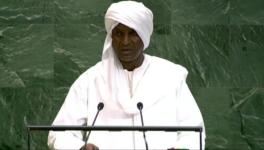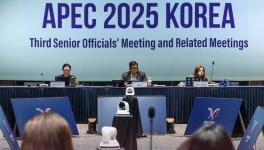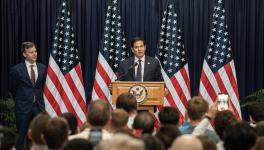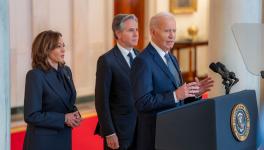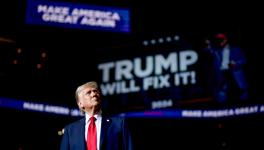Quad is Turning & Turning in Widening Gyre
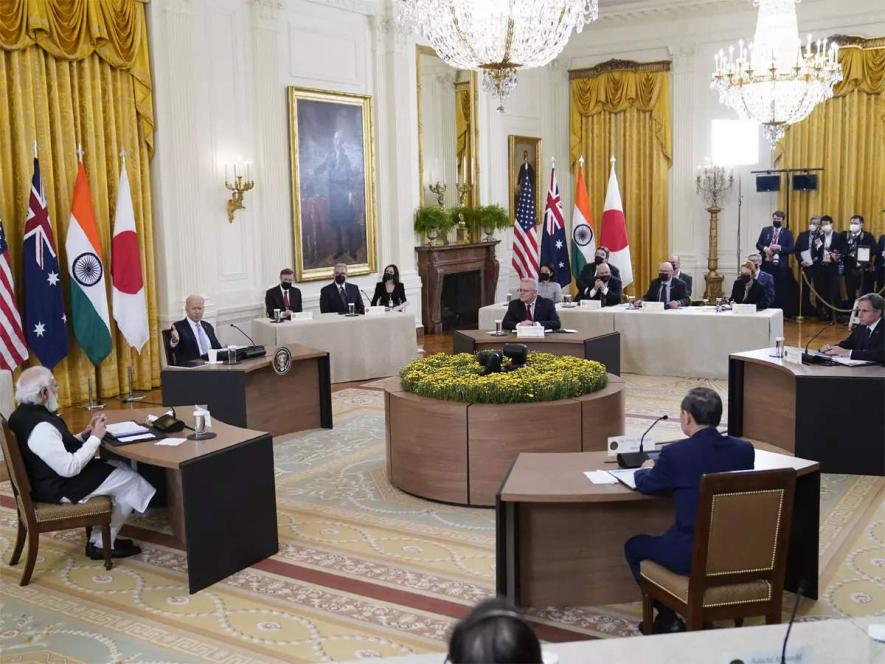
Image Courtesy: AP
By coincidence, perhaps, on the same day that President Joe Biden hosted the first Quad summit, he also cleared the way for a senior executive of Huawei Technologies to return to Beijing — “removing one major irritant between the two superpowers,” as the New York Times put it.
Meng Wanzhouthe’s release made headlines overshadowing the Quad event. Beijing reciprocated instantly by releasing a former Canadian diplomat Michael Kovrig and businessman Michael Spavor. Meng’s detention had “major geopolitical implications, further souring relations between Beijing and both Washington and Ottawa,” Washington Post noted.
Perhaps, something of that “feel-good” rubbed on the Quad joint statement, where Washington agreed that the grouping stood for “a free and open Indo-Pacific, which is also inclusive and resilient.” [Emphasis added.]
Washington’s stubborn refusal to utter that nine-letter word “inclusive” was meant to be a jab at China, and the shift is a sign of realism. It hints at renewed overture to the ASEAN (Association of South East Asian Nations) and an attempt to assuage the European sentiments aggrieved over the US pivot away from the transatlantic alliance.
Contextually, as WaPo put it: “Coming on the heels of a diplomatic blowup over a US plan to sell nuclear-powered submarines to Australia [AUKUS], the Biden administration sought to play down the idea that the Quad grouping could become a new kind of trans-Pacific military alliance. Rather, US officials call it “informal” and nonmilitary. Biden also did not mention China by name during his address to the United Nations General Assembly earlier this week, though he told the gathering that he does not seek “a new Cold War.”
The desire to counterbalance China drove the Quad countries to invest in intellectual and diplomatic terms in the “Indo-Pacific” concept, but the issue of cohesion remained unresolved. Historically, multilateralism is a complex idea for Asian psyche, given their saga of national liberation from colonial rule in the last century and their trajectory of nation-building riveted on hard-won national sovereignty.
Unease over China’s rise is simply not sufficient enough to rally behind the American flag. This remains the great fault line in the “Indo-Pacific” concept. Belatedly, the Americans seem to grasp that India cannot be made a compliant partner.
While India’s relationship with China is far from optimal today, its abiding interest to get close to China is also self-evident. Simply put, geopolitics gives impetus for India to be an autonomous actor.
India gains nothing out of antagonising China or being used as a proxy diplomatic weapon and, certainly, it has no reason to carry the burden of others’ rivalries with China. Fundamentally, India has its own strategic interests, like the ASEAN countries, and is a stakeholder in the stability of the Asian continent.
So far, the Quad’s output has been rather meagre. The joint statement once again speaks mostly in generalities. The only concrete outcome is the creation of the Quad Fellowship, which will provide 100 graduate fellowships to leading science, technology, engineering, and mathematics graduate students across the four countries. No small initiative, but not enough to write home about.
When it comes to hot button issues, though, with all the huffing and puffing by the Quad, China’s Belt and Road Initiative (BRI) remains the more compelling international vision than the “Indo-Pacific”. It has caught the imagination of the world, as is apparent from the big attendance at the biannual BRI summits in China. Basically, BRI is flexible and specific, while “Indo-Pacific” is ideological and other-worldly. It is not difficult to see why the Quad has a scratchy record.
Washington has been desperately in need of some foreign-policy showpiece in the aftermath of the defeat and humiliating retreat from Afghanistan and it announced the AUKUS. But the US behaviour toward France, a major key NATO (North Atlantic Treaty Organisation) ally, a nuclear power and a permanent UN Security Council member, is something unprecedented, even Trump did not allow himself such boorish behaviour.
AUKUS has serious nuclear proliferation risks and violates the spirit of the NPT (Non-Proliferation Treaty), as the US nuclear submarines are fuelled by HEU (Highly Enriched Uranium) of above 90%, which is weapon-grade nuclear material. It undercuts the South Pacific Nuclear Free Zone Treaty and ASEAN countries’ efforts to build a non-free zone in Southeast Asia — all in all, severely undermining regional peace and stability.
Meanwhile, France’s relations with Australia and the US are now severely damaged, whereas France also happens to be a serious Indo-Pacific power with significant sovereign interests, which hosts some 1.5 million citizens and more than 90% of its large Exclusive Economic Zone (nine million km²) and maintains a military presence of 8,000 personnel to take care of this vast area.
Make no mistake, France’s Indo-Pacific commitment will not weaken and it will step up efforts to build up a network of middle powers in the region, including India, outside the orbit of QUAD and AUKUS. The French and European’s inclusive visions for the Indo-Pacific are also convergent with the ASEAN approach. Clearly, the decision on AUKUS is a hasty move by a besieged US president who took heavy battering lately on the foreign policy front. Beijing is taking it calmly.
There are contrarian currents in play in the Indo-Pacific. Curiously, Beijing lobbied Australian parliament as recently as in early September to help it to join the Comprehensive and Progressive Agreement for Trans-Pacific Partnership (CPTPP) in a nuanced signal that the two economies have enormous potential for cooperation despite recent hiccups in their relationship.
Chinese pundits envisage Canberra’s support to China in joining CPTPP in exchange for Beijing reopening its market to Australian products before the election next year. Not surprisingly, the Chinese Foreign Ministry has called on the Biden Administration to “revoke the wrong decision” on AUKUS.
At any rate, Australia is a novice in building nuclear submarines. A Russian analyst wrote in Vzglyad newspaper: “Is it possible for the Australians to meet the deadlines?.. And this requires, firstly, shipyards in sufficient quantity to build submarines; secondly, workers and engineers; and thirdly, the supply of components from the United States, which can become the bottleneck of the project because of the existing crisis in American shipbuilding. Does Australia have all this in the right amount? The allies will not be able to help; they do not have enough themselves.”
The Americans themselves take five years to build one ‘Virginia’ from the point of laying the keel to delivery to the US Navy! Such being the case, Australia’s fleet of nuclear submarines armed with ballistic missiles will need several decades to see the light of day.
Meanwhile, trends emerging in Sino-US economic and trade development show great momentum so much so that the new Chinese ambassador in Washington, Qin Gang, noted thoughtfully the other day, “If we compare China-US relations to a giant ship, then economic and trade cooperation has been its ballast and propeller. When the ship sails against heavy winds and huge waves, we need to add more strength to the ballast and propeller.”
Suffice to say, Biden’s decision on Meng’s release is a big gesture alongside his quiet burial of the COVID-19 origin file. The ultimate litmus test for Beijing would be, arguably, that Biden orders that the East Turkestan Islamic Movement is put back in the US State Department’s list of terrorist groups. Biden has already proposed a summit meeting with President Xi Jinping.
The message out of the Quad summit is that the consummate statesman in Biden didn’t visualise it as a game-changing event to corner China. He passed on to Vice-President Kamala Harris the delegation-level talks with Prime Minister Narendra Modi.
In diplomacy, long-winded statements become necessary when there is little substance to convey. The Quad statement has 2,145 words, yet says so little that we already did not know.
Get the latest reports & analysis with people's perspective on Protests, movements & deep analytical videos, discussions of the current affairs in your Telegram app. Subscribe to NewsClick's Telegram channel & get Real-Time updates on stories, as they get published on our website.









